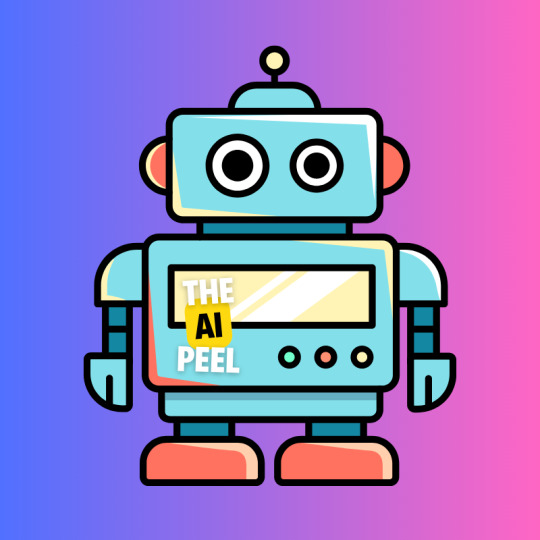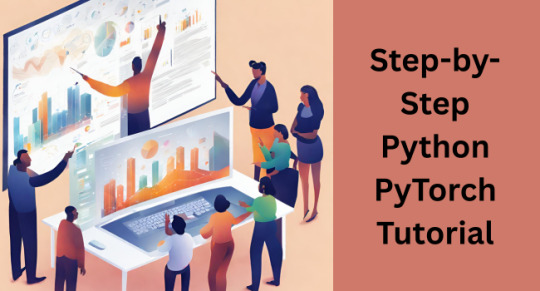#neural network tutorial
Explore tagged Tumblr posts
Text
The Ai Peel

Welcome to The Ai Peel!
Dive into the fascinating world of artificial intelligence with us. At The Ai Peel, we unravel the layers of AI to bring you insightful content, from beginner-friendly explanations to advanced concepts. Whether you're a tech enthusiast, a student, or a professional, our channel offers something for everyone interested in the rapidly evolving field of AI. What You Can Expect: AI Basics: Simplified explanations of fundamental AI concepts. Tutorials: Step-by-step guides on popular AI tools and techniques. Latest Trends: Stay updated with the newest advancements and research in AI. In-depth Analyses: Explore detailed discussions on complex AI topics. Real-World Applications: See how AI is transforming industries and everyday life. Join our community of AI enthusiasts and embark on a journey to peel back the layers of artificial intelligence.
Don't forget to subscribe and hit the notification bell so you never miss an update!
#Artificial Intelligence#Machine Learning#AI Tutorials#Deep Learning#AI Basics#AI Trends#AI Applications#Neural Networks#AI Technology#AI Research
3 notes
·
View notes
Video
youtube
(via https://youtube.com/watch?v=diUs1SSxnvs&si=Urc_Uyl7Kf93PIWn)
#youtube#PytorchBootcamp CreditLimitAdjustment DynamicCreditLimit DeepLearning DNNinPyTorch CreditRiskAnalysis MachineLearningFinance AIPoweredCredit#Pytorch Bootcamp Credit Limit Adjustment Dynamic Credit Limit DNN in PyTorch Deep Neural Networks Credit Risk Modeling PyTorch Tutorial Mach
0 notes
Text
Ultimate Guide To Advanced AI Painting Techniques And Methods
Over the past decade, artificial intelligence has revolutionized the field of painting, offering innovative tools and techniques that have transformed the way artists create. In this ultimate guide, we will examine the advanced AI painting techniques and methods that are shaping the future of art. From neural networks to generative adversarial networks, we will explore the cutting-edge…

View On WordPress
#Advanced#Advanced techniques#AI#AI painting#artificial intelligence#creative technology#digital art#Digital painting tutorials#Guide#Innovation in art#Machine Learning#neural networks
0 notes
Text
Neural Networks Unraveled: The Ultimate Tutorial for Beginners

In the realm of artificial intelligence, Artificial Neural Networks (ANNs) stand as the bedrock of deep learning. This Artificial Neural Networks tutorial takes you on a captivating journey through the inner workings of ANNs, from their fundamental principles to advanced techniques.
Starting with the basics, you'll gain a solid understanding of neurons, layers, and activation functions. As you progress, you'll delve into the intricacies of training ANNs, exploring backpropagation and optimization methods. Practical examples illuminate every step, ensuring clarity and applicability.
The tutorial doesn't stop at the fundamentals; it extends into advanced concepts. Discover techniques for fine-tuning models, handling overfitting, and implementing convolutional and recurrent layers for specialized tasks.
What sets this tutorial apart is its accessibility to both beginners and seasoned practitioners. Clear explanations and hands-on examples make complex concepts digestible, while advanced insights offer valuable knowledge for experienced enthusiasts.
By the end of this tutorial, you'll be equipped to construct, train, and optimize ANNs for a range of applications, from image recognition to natural language processing.
For an in-depth exploration of Artificial Neural Networks and a wealth of practical knowledge, visit Tutorial and Example. This tutorial is a treasure trove for anyone seeking to master the art of deep learning through Artificial Neural Networks.
0 notes
Text

Dive into the world of Artificial Neural Networks with our comprehensive tutorial. From foundational concepts to advanced techniques, this guide equips you to construct and train ANNs for various applications. Packed with practical examples and clear explanations, it's your gateway to mastering this powerful deep learning tool.
0 notes
Text
NEURAL NETWORKS AND DEEP LEARNING WITH PYTHON A PRACTICAL APPROACH
Master Neural Networks & Deep Learning with Hands-On Python!
Are you ready to go beyond theory and start building real AI models? Whether you're a beginner or an experienced coder, this book is your step-by-step guide to understanding and implementing neural networks and deep learning using Python.
🔍 What You’ll Learn: ✅ The fundamentals of neural networks – from perceptrons to deep architectures ✅ Step-by-step coding tutorials using TensorFlow & PyTorch ✅ How to train, optimize, and fine-tune AI models for real-world applications ✅ Practical projects on image recognition, NLP, and more ✅ Debugging techniques to fix common deep learning mistakes
💡 No more confusion. No unnecessary jargon. Just hands-on learning!
📖 Perfect for: AI enthusiasts, data scientists, students, and developers who want to build and experiment with deep learning in Python.
🔥 Get ready to train your own AI models and bring your deep learning ideas to life!
🔗 [Order now] (https://a.co/d/h2b3ckR) or grab a free sample!
💬 Reblog & share if you love AI and Python! #DeepLearning #AI #Python #MachineLearning #NeuralNetworks

#technology#ai writing#machine learning#neuralnetworks#bookstagram#writerscommunity#indie authors#writing tips
3 notes
·
View notes
Text
im actually tired because every transformer tutorial is like "this is encoder and this is decoder. they both hate u and want to kill you in different ways. and this is a layer of neural networks between them...what does it do? nobody cares. and this is positional encoding. it is the worst thing ever ❤️"
5 notes
·
View notes
Text
How do I learn R, Python and data science?
Learning R, Python, and Data Science: A Comprehensive Guide
Choosing the Right Language
R vs. Python: Both R and Python are very powerful tools for doing data science. R is usually preferred for doing statistical analysis and data visualisations, whereas Python is much more general and currently is very popular for machine learning and general-purpose programming. Your choice of which language to learn should consider your specific goals and preferences.
Building a Strong Foundation
Structured Courses Online Courses and Tutorials: Coursera, edX, and Lejhro offer courses and tutorials in R and Python for data science. Look out for courses that develop theoretical knowledge with practical exercises. Practise your skills with hands-on coding challenges using accompanying datasets, offered on websites like Kaggle and DataCamp.
Books: There are enough books to learn R and Python for data science. You may go through the classical ones: "R for Data Science" by Hadley Wickham, and "Python for Data Analysis" by Wes McKinney.
Learning Data Science Concepts
Statistics: Know basic statistical concepts: probability, distribution, hypothesis testing, and regression analysis.
Cleaning and Preprocessing: Learn how to handle missing data techniques, outliers, and data normalisation.
Data Visualization: Expert libraries to provide informative visualisations, including but not limited to Matplotlib and Seaborn in Python and ggplot2 in R.
Machine Learning: Learn algorithms-Linear Regression, Logistic Regression, Decision Trees, Random Forest, Neural Networks, etc.
Deep Learning: Study deep neural network architecture and how to build and train them using the frameworks TensorFlow and PyTorch.
Practical Experience
Personal Projects: In this, you apply your knowledge to personal projects which help in building a portfolio.
Kaggle Competitions: Participate in Kaggle competitions to solve real-world problems in data science and learn from others.
Contributions to Open-Source Projects: Contribute to some open-source projects for data science in order to gain experience and work with other people.
Other Advice
Join Online Communities: Join online forums or communities such as Stack Overflow and Reddit to ask questions, get help, and connect with other data scientists.
Attend Conferences and Meetups: This is a fantastic way to network with similar working professionals in the field and know the latest trends going on in the industry.
Practice Regularly: For becoming proficient in data science, consistent practice is an indispensable element. Devote some time each day for practising coding challenges or personal projects.
This can be achieved by following the above-mentioned steps and having a little bit of dedication towards learning R, Python, and Data Science.
2 notes
·
View notes
Text
youtube
Discover how to build a CNN model for skin melanoma classification using over 20,000 images of skin lesions
We'll begin by diving into data preparation, where we will organize, clean, and prepare the data form the classification model.
Next, we will walk you through the process of build and train convolutional neural network (CNN) model. We'll explain how to build the layers, and optimize the model.
Finally, we will test the model on a new fresh image and challenge our model.
Check out our tutorial here : https://youtu.be/RDgDVdLrmcs
Enjoy
Eran
#Python #Cnn #TensorFlow #deeplearning #neuralnetworks #imageclassification #convolutionalneuralnetworks #SkinMelanoma #melonomaclassification
#artificial intelligence#convolutional neural network#deep learning#python#tensorflow#machine learning#Youtube
3 notes
·
View notes
Text
Techaircraft
Dive into the world of Artificial Intelligence with Python! 🐍💡 Whether you're a seasoned coder or just starting, Python’s versatile libraries like Tensor Flow, Kera's, and sci-kit-learn make it easier than ever to build intelligent systems. 🤖 From developing predictive models to creating advanced neural networks, Python is your gateway to the future of technology. 📈🔍 Explore data analysis, natural language processing, and machine learning with hands-on projects that unlock endless possibilities. 🌐💻 Ready to level up your AI skills? Follow along for tutorials, tips, and inspiration to turn your innovative ideas into reality. . 𝐖𝐞𝐛𝐬𝐢𝐭𝐞 - www.techaircraft.com
𝐓𝐞𝐜𝐡𝐚𝐢𝐫𝐜𝐫𝐚𝐟𝐭 𝐬𝐮𝐩𝐩𝐨𝐫𝐭 𝐝𝐞𝐭𝐚𝐢𝐥𝐬:
𝐌𝐨𝐛𝐢𝐥𝐞 𝐍𝐮𝐦𝐛𝐞𝐫 - 8686069898
#ArtificialIntelligence#PythonProgramming#MachineLearning#DataScience#TechInnovation#NeuralNetworks#DeepLearning#CodingLife#PythonDeveloper#AIProjects#FutureOfTech#TechTrends#Programming#DataAnalysis#TensorFlow#Keras#ScikitLearn#LearnToCode#AICommunity#Innovation

2 notes
·
View notes
Text
youtube
Discover 8 incredible AI animation tools that are completely free to use! From creating realistic depth animations to animating children’s drawings, these tools will revolutionize your workflow. In this video, we’ll explore powerful options like Minimax for text-to-video creations, Viggle for viral animations, and Immersity AI for immersive depth effects. Plus, find out how to upscale your animations effortlessly with tools like CapCut and Krea. Whether you’re a content creator, animator, or just curious about AI, these tools will unlock new possibilities for your projects. Don’t miss the bonus tool at the end—it’s a game-changer for animation enthusiasts! Check the links below to access these tools and stay ahead in the AI revolution. Tools Mentioned: Minimax: https://hailuo.ai Viggle: https://viggle.com Krea: https://krea.ai Hydra: https://hydra.ai Adobe Express: https://express.adobe.com Animated Drawings by Meta: https://animateddrawings.com Immersity AI: https://immersity.ai CapCut: https://www.capcut.com Remove.bg: https://www.remove.bg Futurepedia: https://www.futurepedia.io #AIAnimation #FreeAI #AnimationTools #AIArt #ContentCreation #AIHacks #DigitalCreators #AnimationTips #AIRevolution FREE AI Animation Tools That Will BLOW Your Mind published first on https://www.youtube.com/@TheAiPeel/
#Artificial Intelligence#Machine Learning#AI Tutorials#Deep Learning#AI Basics#AI Trends#AI Applications#Neural Networks#AI Technology#AI Research#Youtube
0 notes
Text

Artificial Intelligence (AI) Tutorial
This AI Tutorial is designed to introduce learners to the fascinating world of Artificial Intelligence. Starting with foundational concepts such as machine learning, neural networks, and natural language processing, it gradually transitions into real-world applications and hands-on projects.
Visit our website for more information: https://www.tpointtech.com/artificial-intelligence-ai
0 notes
Text
How To Create Mind-Blowing Art With DeepDream
Choose Art Style Realistic or Abstract Even though DeepDream can transform ordinary images into surreal pieces of art, it’s crucial to decide whether you want a realistic or abstract art style. Realistic art focuses on capturing the essence of reality with intricate details and lifelike representations, while abstract art allows for more experimentation and interpretation. Modern or…

View On WordPress
#ai art#AI art creation#AI artistry#ai creativity#ai generator#ai image#art inspiration#ArtificialIntelligence#Artistic neural networks#Creative AI tools#creative technology#Creativity#Deep Learning#DeepDream#DeepDream art#DeepDream tutorial#Digital art techniques#Digital Creativity#Machine Learning#Neural network creativity#neural style transfer
1 note
·
View note
Text
Beginner’s Python PyTorch Tutorial: Start Your AI Journey Today

If you are interested in learning deep learning and artificial intelligence, then this Python PyTorch Tutorial is perfect for you. PyTorch is a popular open-source library used for machine learning and deep learning projects. It is developed by Facebook and widely used by researchers, developers, and data scientists.
This tutorial is made especially for beginners who want to understand the basics of deep learning. PyTorch is known for its simple and flexible design. It allows you to build, train, and test deep learning models with ease. One of the best features of PyTorch is its dynamic computational graph, which means you can change things on the go while building models.
In this Python PyTorch Tutorial, you will learn how PyTorch works, what tensors are, and how neural networks are created using this powerful library. The tutorial also covers important concepts like model training, loss functions, and optimizers—all explained in simple language.
Whether you want to build image recognition models, natural language processing applications, or any AI-related project, PyTorch is a great choice. Its clean syntax and helpful tools make learning deep learning less complicated for beginners.
If you are just starting out, don’t worry! This tutorial breaks down every concept in an easy-to-understand way. Begin your AI journey today with PyTorch.
To learn more and continue your learning, visit the Python PyTorch Tutorial
0 notes
Text
Revolutionizing Audio: The Power of AI Music Generators in 2025
In recent years, artificial intelligence has begun reshaping virtually every creative industry—from design to storytelling. Now, the music world is undergoing its own AI-driven evolution. AI music generators are gaining ground, allowing amateurs and professionals alike to compose, remix, and experiment with music like never before.
This technological leap is not just about replacing musicians or composers—far from it. It’s about augmenting creativity, simplifying workflows, and expanding access to music production for everyone. In this article, we’ll dive deep into how AI music generation works, who it’s for, and how tools like Adobe Express are leading the way.
What Is an AI Music Generator?
An AI music generator is a tool powered by machine learning algorithms that can autonomously create musical compositions based on a set of inputs or parameters. Whether you’re seeking background scores, theme songs, or looped beats, these systems can generate original tracks in seconds.
Most AI music tools use datasets containing thousands—sometimes millions—of existing music samples. The algorithm “learns” patterns of rhythm, melody, harmony, and structure to produce new compositions that sound human-made.
How Does AI Generate Music?
AI music generation combines elements from several machine learning disciplines, including:
Neural networks that model musical sequences
Natural language processing (NLP) to interpret textual prompts
Audio signal processing for realistic synthesis
Reinforcement learning for refining outputs based on feedback
When you enter a prompt—such as “lo-fi beat for studying” or “upbeat electronic track”—the AI interprets it, references its trained data, and generates a composition accordingly.
Some platforms offer customization options, letting you choose the length, genre, instruments, and even tempo. Others provide downloadable files for use in videos, games, podcasts, or digital campaigns.
Why AI Music Generators Are Game-Changers
1. Accessibility for Everyone
Before AI, music production required expensive software, studio time, and years of training. AI generators now let marketers, content creators, and hobbyists compose music without ever learning to play an instrument.
2. Faster Production Cycles
Need royalty-free background music for your YouTube video? AI music tools can generate multiple variations within seconds—far faster than traditional methods.
3. Cost-Efficiency
Hiring composers or purchasing music licenses can be expensive. AI tools are often subscription-based or even free, making them a budget-friendly alternative.
4. Creativity on Demand
Sometimes, inspiration doesn’t strike on time. AI fills the gap with endless creative suggestions, letting you build on machine-made melodies with your own edits.
Adobe Express: A Leading AI Music Generator
Among the growing field of AI tools, Adobe Express AI Music Generator stands out for its simplicity and quality. Known for its excellence in design and media tools, Adobe has expanded its Express suite to include intuitive music creation.
Key Features:
Easy-to-use interface for beginners and pros alike
Variety of genres including classical, hip hop, electronic, and more
Fast rendering and export options
Royalty-free tracks for personal and commercial use
Whether you’re scoring a presentation, short film, or social media post, Adobe Express makes it possible to create custom music with just a few clicks.
Who Can Benefit from AI Music Generators?
The applications are nearly endless. Here’s who’s already using AI to create music:
Content creators & YouTubers: Background music for vlogs, tutorials, and intros
Game developers: Ambient loops or interactive soundtracks
Educators: Audio snippets for online courses or presentations
Businesses: Custom jingles or sound branding
Musicians: As a base to build original compositions or collaborate with AI
Limitations to Keep in Mind
As with all AI tools, there are some caveats:
Originality: Though unique, AI-generated tracks may resemble pre-existing works. Always check for copyright concerns, especially when using outputs commercially.
Emotion and nuance: AI can emulate styles but may lack the deep emotional resonance of human-made music.
Customization limits: While tools are improving, they still can’t match the detailed precision of manual production in complex compositions.
Still, these trade-offs are quickly shrinking as AI continues to evolve and integrate more sophisticated datasets.
Ethical and Legal Considerations
As AI-generated content becomes more prevalent, new legal questions emerge:
Who owns the music: the user or the platform?
Can AI-generated music be copyrighted?
How will this affect employment in the music industry?
Platforms like Adobe have begun addressing these by offering clear terms of use and royalty-free licensing. However, creators must stay informed about how content can be used, particularly in monetized or public-facing projects.
Future Outlook: AI’s Role in Music Creation
The next few years will likely bring even more powerful tools that:
Integrate voice and lyric generation
Offer real-time collaboration with human musicians
Adapt compositions dynamically in response to user feedback
Blend genres and cultural elements more seamlessly
AI is not a replacement for human creativity but a robust companion to it. The best results will come from collaboration between man and machine, where human emotion meets algorithmic efficiency.
Final Thoughts
AI music generators are democratizing music like never before. They empower people with no formal training to create soundtracks, beats, and melodies instantly, and allow seasoned artists to push the boundaries of creativity.
Whether you’re a content creator needing quick background tracks or an innovator eager to experiment with new soundscapes, tools like Adobe Express AI Music Generator are opening doors to a future where anyone can compose music—no studio required. As technology continues to evolve, one thing is clear: the future of music is being written not just by composers, but also by code.
1 note
·
View note